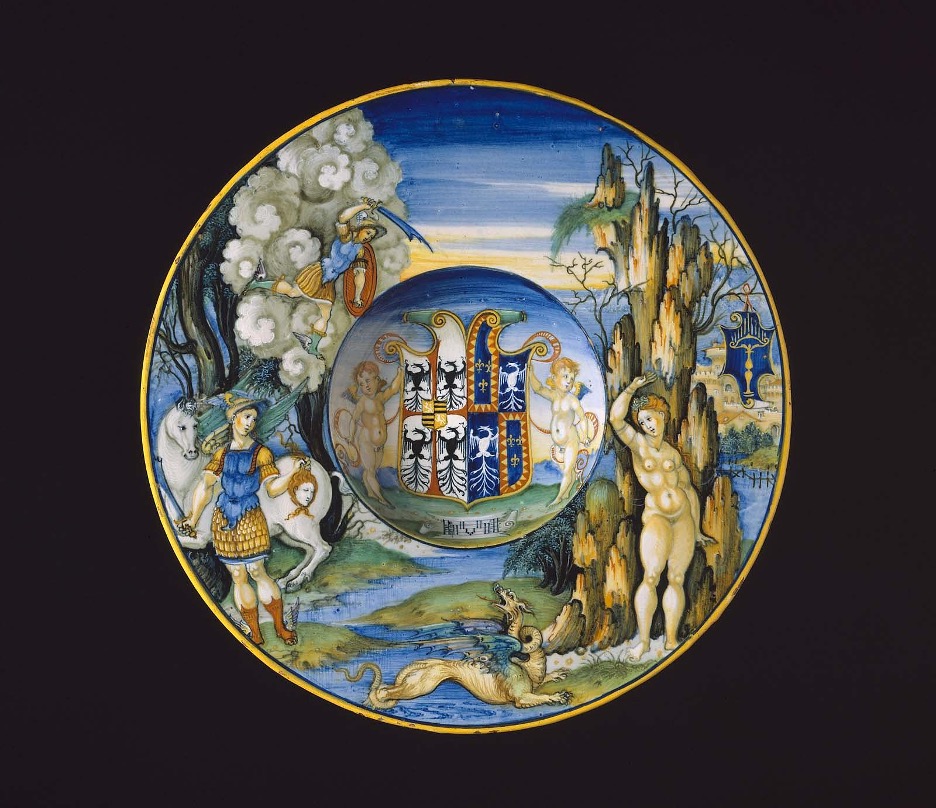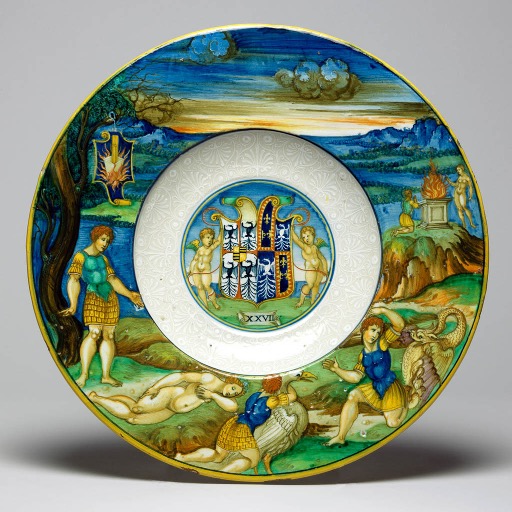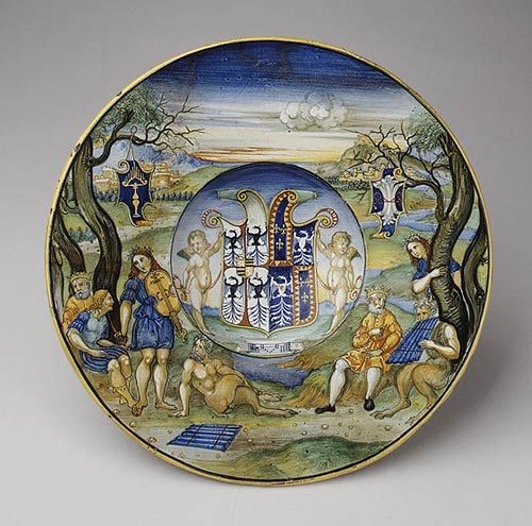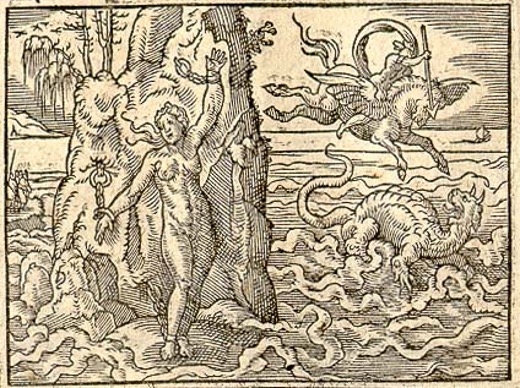by Nyala Honda

Though many view the Italian Renaissance as an era of artistic expansion transcending mediums, artistic disciplines traditionally labeled as craft and their development during this time have not been at the forefront of historical investigation. Italian Majolica ware, a subset of Italian ceramics, experienced immense growth in terms of quality and quantity during this time, a result of innovations in painting and sculpture. As ceramics and functional art were more accessible and reached a greater audience, consideration of the narratives and expression within these works can be used to evaluate the more extensive tastes and values of the Renaissance.
In considering sculptural works produced during the Italian Renaissance, ceramics, specifically functional work, are often overlooked and forgotten as a part of this epoch of artistic fervor. The term “Renaissance Sculpture” brings to mind Michelangelo’s David, Cellini’s Perseus and Medusa, Donatello’s Gattamelata, and other monumental works that were unprecedented. Nicola da Urbino’s Plate depicting Persus and Andromeda in the Gonzaga Service exemplifies this through carefully-painted motifs reflecting the humanist ideals of the time and embedded iconography sacred to his patron. In looking more intently at these objects, we can construct a narrative of an era, meals shared together, the blur of conversation about past lives, and the hands which cleaned and cared for an object so remarkable, yet so ingrained in the domestic rituals of humanity.
Majolica, as executed in Nicola da Urbino’s work, can be traced back to the tin-glazed pottery of the Islamic world, an attempt to imitate Eastern Asian porcelain. This technique first came to Italy in Sicily1 and spread throughout the peninsula, taking root in regions such as Faenza, Deruta and Urbino. Majolicaware became very popular throughout Italy, in large part due to a higher level of craftsmanship which came with significant improvements in ceramic technology. This can be seen in the development of three-layer firings,2 which produced consistency and more durable wares. Additionally, the variety of pigments increased, and different ceramic centers began to identify with different colors, representing pride in the work produced and associated with a given city. These goods were often produced in small workshop settings with workers following the direction of a master potter who dictated their function within the workshop. The streamlining of this process into what resembles a line of production resulted in the growth of the industry and higher consumer demand. In the late 16th century, Cipriano Piccolpasso published the first treatise on Majolica, dispersing the information that had once been elusive, and standardizing methods of constructing, glazing, and decorating wares. This publication aided in the increase in production and thus the popularity of majolica ware throughout Italy and other regions of Europe.
Majolica production grew throughout the Renaissance, as transportation became more efficient and a newly-developed middle class joined the consumer market for material goods. Prior to this, the elite had dined with mostly gold and silver dishes3, while the lower class ate off of wooden ones. Majolica provided an inexpensive, more sanitary alternative for lower classes, yet simultaneously a surface which could be decorated to reflect the splendor and ideologies of the higher class. The versatility of these objects is a large reason that they were so successful, and shows the fluctuation of the economic state of Italy during this time. The development of ceramic centers throughout Italy reflects these conditions, and potters had to form communities to share kilns and other resources that were difficult to acquire individually. Another reason for the success of Majolica in the Renaissance was that there were a larger variety of functions for which the wares were suited. For example, pharmacy jars were a popular commodity in Florence as a result of a new interest in apothecary, which requires small containers to hold ingredients. Furthermore, there was an increase in the varieties of foods being prepared in different fashions, opening the possibility of a stratification of wares for different purposes. Majolicaware began to take on its own style, allowing Italian potters to make work equivalent with ceramic goods that had previously been imported. The rise in popularity of istoriato4 majolica allowed for the transmission of visual culture onto everyday objects, signifying the consideration of the narratives circulating society during the time.
Nicola da Urbino, or Nicola di Gabriele Sbraghe, was a master of Majolica who created most of his work in Urbino, an important ceramic center during the Italian Renaissance. Most of his work is done in the isoriato fashion, and he was known for producing work that was very pleasing to his patrons. His most famous patron was Isabella d’Este,duchess of the Gonzaga Court, the first known female patron of the Renaissance. Her role as a prominent collector and sociopolitical influence has made her one of the most remarkable figures from the Renaissance. Artistic developments in other mediums can be reflected through Nicola da Urbino’s work, specifically in his use of perspective. Renaissance printmaking and drawing also served as inspiration for his work. The artist was inspired by the Venetian painters, specifically Giorgione, which can be seen in his depictions of landscapes and atmospheric perspective. Nicola da Urbino drew most of his imagery from Ovid’s The Metamorphosis and the Hypnerotomachia Poliphili, texts cited for their romantic undertones. He was especially inspired by the woodblock prints from The Metamorphosis, as can be seen through his work in his use of line as a dominant visual element.5 This relationship between the woodblock prints and ceramics is an example of Mannerism, a dominant fixture in the Renaissance art scene. Translating from previous works of art rather than antique models or the natural world was a hallmark of this movement, resulting in more stylized and expressive works. Nicola da Urbino also produced the Correr Service, a notable work that is considered by many the pinnacle of Renaissance ceramics in the istoriato style.
The Gonzaga service itself was created for Isabella d’Este in 1524, commissioned by her daughter Eleanora. A second service for Isabella d’Este’s son, Fedrico, was also created by Urbino in 1533 to commemorate his marriage to Margherita Paleologa. The family was noted as working with Nicola da Urbino on several occasions, and the correspondence between the artist and Isabella d’Este reflects her role in the creative decision-making for her commissions. Some of these commissions were politically motivated and sent as diplomatic gestures to important figures with whom the Gonzaga court interacted.6 The Gonzaga service wares were used in the suburban palace of the Gonzaga Court7, a space intended for leisure and socializing rather than the complexities of political affairs. The family hosted many social gatherings and events to facilitate conversation about culture, antiquity and literature, at which they would use their majolica dishes to impress their guests. The service for Isabella d’Este contains motifs that reflected her character and role as a mother, wife, politician and citizen, connecting back to the dominant role of humanism in the Renaissance. Isabella d’Este was educated in many different humanist subjects, and was also known for being patron of music as well as art. She preferred her own suburban palace and created her own iconography that can be seen in the spaces that she designed. Understanding the context for the Gonzaga service is crucial in understanding the design of these pieces, and their function within the space. In considering this, the viewer may also conceptualize the aspect of leisure within the lives of the intellectual and political elite.
Nicola da Urbino’s Plate depicting the story of Perseus and Andromeda serves as an encapsulation of the artist’s skills in creating an appropriate three-dimensional form on which to render complex, painterly imagery. Perseus is depicted holding the head of Medusa, alluding to his heroic status, wearing winged sandals, a gift from Hermes, and another visual marker of his identity. Pegasus, who plays an important role in the myth, is positioned behind Perseus, exhibiting loyalty through his gaze and stance. Andromeda is shown gazing at Perseus, nude and chained to a rock in the foreground of a dream-like landscape rendered using atmospheric perspective. A river flowing from the horizon contains the sea monster intended to kill Andromeda, while a second depiction of Perseus hovers above, in position to slay the monster and save Andromeda. The figures of Perseus and Andromeda that are positioned opposite each other are styled in a contrapposto stance, while the flying iteration of Perseus reflects the Renaissance development of the rendering of the figure in motion. All of the human figures, including the head of Medusa, are depicted according to the standards of beauty during this time, with light hair and very fair skin. Particular attention is paid to the exaggerated musculature of the figures, exhibiting the influence that the Mannerist movement may have had on the artist. The musculature of the female figure in particular also seems based in male anatomy, potentially suggesting that Nicola da Urbino had a more extensive understanding of male anatomy, most likely due to the lack of female models during the time period. In the center of the plate, the arms of the Gonzaga and Este family are fused together, positioned between two putti. Beneath the feet of the putti is a musical line, denoted on a small scroll. The castle in the background further hints at the ending of the myth in which Perseus marries the princess. The overall composition of the plate within the tondo8 format exhibits an understanding of figure and environment that demonstrates the technical skill of Nicola da Urbino, which marries with his knowledge of ceramic forms to produce this work.
Nicola da Urbino pays particular attention to the line quality of his forms, using a combination of harsh and organic lines to render the scene. In closely observing Medusa’s hair, and the trees, the artist’s personal style merges with an understanding of nature, producing a deviation from naturalism that still clearly represents the myth. The varied colors in the composition also show Nicola da Urbino’s painterly inclinations. The blue and yellow hues dominate the scene, almost obscuring all the white of the majolica. Nicola’s ability to create convincing skin tones using these pigments is a prominent feature of this work, specifically in the delineation of the muscle groups in Andromeda and Perseus’s extremities. The distinct tonalities of the colors aid in creating a complex composition, especially with regard to the environment. Another interesting aspect of this work is the stylization of the cloud behind the flying figure of Perseus. The shape helps to distinguish the figure from the other edition of Perseus, and adds a celestial aura to this moment of action, a possible reference to the gods that aided him on his quest. The relationships between the standing Perseus and Andromeda and the one between the flying Perseus and the sea monster are indicated by their gazes, creating invisible lines between the figures and assisting the development of the narrative.
The landscape of the plate alludes to the fantastique,9 specifically in the movement in the trees, the visual quality of the cloud, and the texturing of the rock, in conjunction with the mythological figures. Nicola da Urbino uses many of these natural elements to frame the figures and create a sense of drama. The landscape appears to serve as an additional character in the image, which aligns with the presence of the gods reflected through their respective elements. Though no gods are represented in this work, their influence and role in the story are clear, an additional show of the subtleties contained within the plate. By considering Nicola’s influences, the viewer can observe parallels between the woodblock prints of Metamorphosis and the Venetian school of painting. The position of Andromeda remains the same in both the woodblock (Figure 1) and Nicola da Urbino’s plate. The trees and stylization of the water is also reflected in Nicola’s rendition of the myth, showing movement and action emphasized through line.
An important hallmark of the Italian Renaissance that must be considered in this is the function of aesthetics in society. During a period in which society looked to antiquity in setting standards of beauty and naturalism, imitation of highly exalted works from the past was considered to show more skill than individual stylization. Beauty and virtue were often considered one in the same, leading those who could afford it to pursue goods in line with the standards of beauty of the day. The relationship between aesthetics and character produced demands from the patron that are reflected in the work produced during the Renaissance. A contributing agent to the aesthetic of Nicola da Urbino’s work is the shape. The ceramic form of the plate lends itself to the tondo, a shape that was very popular in the Italian Renaissance. The tondo was closely linked with domestic devotional items10, especially images of Madonna and Child. The form is thought to be inspired by medallions. Conceptually, the circle was thought to invoke celestial and ideas about everlasting life, another archetype derived from antiquity. The relationship between the divine and the domestic that is implied by the tondo has an interesting connection to the plate form, especially in consideration of the plates as decoration on display.
Viewing the elements of this work, and considering its context within the Renaissance, this ware proves highly descriptive of the cultural values of the time, especially amongst the elite class. A through line of the Renaissance is humanism, and this work is no exception in reflecting this. The subject matter and its emphasis on the feats of man, amorous connection, and focus on the body demonstrates this key feature that can be seen throughout most art produced in the Renaissance. Additionally, its reference to antiquity aligns with other works describing a similar subject: a hero surpassing the human condition and showing their true capabilities. The conversation between Renaissance Italy and Ancient Rome was incredibly prevalent during the time, making this a very appealing status symbol, and perhaps serving as a justification for the Gonzaga Court’s right to power.
An aspect of the work that sets it apart from others created during the time period is rooted in the material, and its link to the domestic, raising questions about art and gender during the Italian Renaissance. Because ceramics, specifically pottery, were (and by many accounts still are) considered decorative art, it was not as gender-specific as many other works of sculpture. Sculptures created with more expensive materials such as bronze and marble were commissioned by men in power with excessive wealth, and the product reflects their desires. Majolica, on the other hand, was significantly more inexpensive, not monumental, and used within the household, a setting closely tied with female gender roles of the era. This aspect of the medium was most likely a contributing factor in Isabella d’Este’s ability to have so much input in the commission, thereby facilitating her role as a patron and development of her own iconography. Additionally, because of their function, these objects had to please both men and women, adding a new element to the work that is unique to Renaissance ceramics. Pottery itself was not conducive to shows of power in the traditional way, resulting in them being almost overlooked by men with regard to women asserting a sense of self and influence through art.11 In considering the set’s commemoration of Federico’s marriage to Margherita Paleologa,12 majolica can be seen as a marital object, similar to that of a cassoni.13 Unlike a cassoni, these services were not meant to inform a woman of how to behave in a marriage, but rather to reflect the intellectual prowess and knowledge of culture of the individuals, and their unification. This same idea can be seen in the Plate depicting the story of Perseus and Andromeda, as the center of the plate depicts the unification of the Gonzaga and Este family crests. Marriage, during this time and even in a contemporary sense, was more complex than lust or love, but rather represented a consolidation of power, especially amongst families such as these. The illustration of the crests demonstrates this perspective and gives a sense for the role that Isabella d’Este had to fulfill. Another work in the service, Plate depicting the story of Peleus and Thetis (Figure 2) also relates to ideas of fidelity, matrimony, and the women’s roles within marriage.

When considering the gender dynamics ingrained in this work and its companions in the Gonzaga service, it is essential to consider the subject matter. The story of Perseus and Andromeda is similar to those in antique and Christian lore, such as the stories of Saint George and the Princess and Atalanta and Hippomenes, which describe intelligent, brave, and virtuous young men who earn the affections of women through salvation, wit and heroism. These stories revolve heavily around marriage, a topic prominent throughout the Italian Renaissance, as the idea of legacy and continuation of knowledge and lineage grew. Though these stories do show a somewhat distorted view of gender roles, especially that of Perseus and Andromeda, as Perseus is holding Medusa’s head, these amorous tales would have been appealing to Isabella d’Este as a sign of strength within her marriage and affirmation of her role as a duchess. Additionally, these wares would have reflected Isabella d’Este’s classical education, serving as an indicator of her erudition and ideals. In some of the other works in the Gonzaga service, such as The Story of King Midas (Figure 3), symbols aside from the crests of the families can be observed and analyzed. The bundle of lottery tickets and musical notation can be connected to Isabella d’Este’s understanding of her own wealth14 and her passion for music. By creating her own symbols and translating them into her possessions, Isabella d’Este establishes herself as a person of enough influence to have her own visual language, transcending the gender roles put in place during the Italian Renaissance.

Another aspect of the Plate depicting Perseus and Andromeda that distinguishes it from other sculptural works of the time is its role at the intersection of craft and fine art. Though it should be noted that these distinctions were not as pervasive during this time period, and these were brought about later by Vasari and the emergence of the art academy, the inexpensive nature of ceramics and its scale did leave it overlooked as a form of sculpture. The contemporary understanding of the differences between craft and fine art are based in functionality, materiality and human touch15 as elements of craft, whereas fine art is stated to be solely in pursuit of beauty. Craft fields, such as ceramics, have historically been associated with domesticity, thus intertwining its associations with gender. Ceramic surfaces such as this also provide the unique opportunity for a painted surface on a three-dimensional object. Though reliefs may provide the same narrative quality, the ability of a painting to utilize color and create a sense of environment is unique. In merging a painted and sculptural object, as well as being functional, this ware contains nuances that may not be found in other Renaissance works. Additionally, its role as a more understated object imbibes it with a unique strength, especially for a female patron. Though it did serve a sociopolitical purpose in demonstrating the intellectual prowess of the Gonzaga Court, the ware’s material allows for more experimentation and artistic license than can be taken in works of higher cost that are consequently under a higher level of scrutiny from both patron and general audience. Ergo, works such as this plate might reflect the tastes of the time more accurately than a piece such as a portrait or equestrian statue, which require more attention to underlying meaning and creation of a visual narrative.
The Gonzaga Service represents the pinnacle of Renaissance majolica: a cumulation of technological advancement, classically educated and skilled artisans, and the transmission of knowledge that was so characteristic of the time. By looking more closely at objects that are often overlooked or disregarded as superficial and purely decorative, one can gain a fuller understanding of the conversations and interactions between the intellectual elite of the Renaissance. The uncommon dynamic that ceramic art has with gender and domesticity creates a new lens through which to understand this humanist era, shedding light on those whose tastes are underrepresented in other Renaissance sculpture.
Bibliography
Goldthwaite, Richard A. “The Economic and Social World of Italian Renaissance Maiolica.” Renaissance Quarterly 42, no. 1 (1989): 1–32.
McNab, Jessie. “Maiolica in the Renaissance.” In Heilbrunn Timeline of Art History. New York: The Metropolitan Museum of Art, 2000.
Wallis, Henry. XVII Plates by Nicola Fontana Da Urbino at the Correr Museum Venice: A Study in Early XVIth Century Maiolica. Taylor &Francis, 1905.
Hannover, Emil, and Bernard Rackham. Europe and the Near East Earthenware and Stoneware. London: Benn, 1925.
Kingery, W. David. “Painterly Maiolica of the Italian Renaissance.” Technology and Culture 34, no. 1 (1993): 28–48. https://doi.org/10.2307/3106454.
Rose, Marice E., Alison C. Poe, and Maria F Maurer. “The Trouble with Pasiphaë: Engendering a Myth at the Gonzaga Court.” In Receptions of Antiquity, Constructions of Gender in European Art, 1300-1600. Leiden: Brill, 2015.
Lisa Boutin Vitela.“Isabella d’Este and the Gender Neutrality of Renaissance Ceramics.” Women’s Studies: An inter-disciplinary journal 40, no. 1 (Jan. 2011): 23–47.
Cohen, Thomas V. “Artisans, Objects, and Everyday Life in Renaissance Italy: The Material Culture of the Middling Class.” Journal of Design History 34, no. 3 (2021): 277–79. https://doi.org/10.1093/jdh/epab024.
Kim, N. Conceptual, Biological and Historical Analyses of Craft. In Crafting Creativity & Creating Craft. Advances in Creativity and Giftedness, Weida, C.K. ed. vol 14. SensePublishers, Rotterdam.
Piccolpasso, Cipriano, Ronald Lightbrown, and Alan Craig-Smith. The Three Books of the Potter’s Art. London, Victoria and Albert Museum, 1934.
Ames-Lewis, Francis. Review of Originality and the Art of Craft, by Andrew Ladis and Carolyn Wood. Oxford Art Journal 20, no. 2 (1997): 82–84.
Vitela, Lisa Boutin. “Dining in the Gonzaga Suburban Palaces: The Use and Reception of Istoriato Maiolica.” Academia.edu, June 7, 2014. https://www.academia.edu/es/7283645/Dining_in_the_Gonzaga_Suburban_Palaces_The_Use_and_Reception_of_Istoriato_Maiolica.
Hess, Catherine, George Saliba , and Linda Komaroff. The Arts of Fire: Islamic Influences on Glass and Ceramics of the Italian Renaissance. Getty Publishing, 2004.
Roberta J. M. Olson. “Lost and Partially Found: The Tondo, a Significant Florentine Art Form, in Documents of the Renaissance.” Artibus et Historiae 14, no. 27 (1993): 31–65.
Endnotes
- Richard A. Goldwaithe,“The Economic and Social World of Italian Renaissance Maiolica,” Renaissance Quarterly 42, no. 1 (1989): p. 2. ↩︎
- Three-layer firings included a bisque stage to prepare, a majolica stage in which the glaze was applied, and a clear coperta layer, to finish and strengthen the piece. ↩︎
- David Kingery, “Painterly Maiolica of the Italian Renaissance.” Technology and Culture 34, no. 1 (1993): p. 32. ↩︎
- The istoriato style of majolica shows imagery, often associated with antiquity or Christian iconography depicted on ceramics. ↩︎
- Henry Wallis, XVII Plates by Nicola Fontana Da Urbino at the Correr Museum Venice: A Study in Early XVIth Century Maiolica, Taylor and Francis, 1905 p. 9. ↩︎
- Lisa Boutin, “Dining in the Gonzaga Suburban Palaces: The Use and Reception of Istoriato Maiolica.” Academia.edu, June 7, 2014, p.100 ↩︎
- Ibid. 103 ↩︎
- Tondo: round ↩︎
- Fantastique: an artistic term referring to the overlap of naturalistic and the supernatural ↩︎
- Roberta J. M. Olson, “Lost and Partially Found: The Tondo, a Significant Florentine Art Form, in Documents of the Renaissance.” Artibus et Historiae 14, no. 27 (1993), p. 32. ↩︎
- Lisa Boutin. “Dining in the Gonzaga Suburban Palaces: The Use and Reception of Istoriato Maiolica.” Academia.edu, June 7, 2014, p.72 ↩︎
- Ibid. 103 ↩︎
- Cassoni: marital chest ↩︎
- Daniela Ferrari and Mariarosa Palverini Gobio Casali, eds. “Una ‘Credenza’ Istoriata per Isabella D’Este. Il Servizio Di Nicola D’Urbino Interpretato De Ester Mantovani,” November 2014, p. 34 ↩︎
- N. Kim, “Conceptual, Biological and Historical Analyses of Craft.” In: Weida, C.L. (eds) Crafting Creativity & Creating Craft. Advances in Creativity and Giftedness, vol 14. SensePublishers, Rotterdam, p. 64 ↩︎
